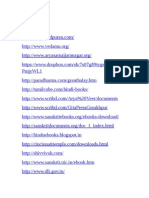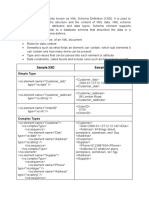0 ratings0% found this document useful (0 votes)
40 viewscreating markup language
Uploaded by
ethioawashmediaCopyright
© © All Rights Reserved
We take content rights seriously. If you suspect this is your content, claim it here.
Available Formats
Download as PPTX, PDF, TXT or read online on Scribd
0 ratings0% found this document useful (0 votes)
40 viewscreating markup language
Uploaded by
ethioawashmediaCopyright
© © All Rights Reserved
We take content rights seriously. If you suspect this is your content, claim it here.
Available Formats
Download as PPTX, PDF, TXT or read online on Scribd
You are on page 1/ 11
Title: Creating a Simple Markup Language
Course/Module Code: EIS WDDBA1 M10 0322
Duration: 70 Hours
Date: 02/03/2017 E.C
Trainer Name:-Bantegizia.Z
Introduction to Markup Languages
• Definition: A markup language is a system for
annotating a document in a way that is
syntactically distinguishable from the text.
• Purpose: Describes document structure and
presentation.
• Examples: HTML, XML, XHTML, DHTML,
SGML, WML, etc.
Acronym
✿ ʜᴛᴍʟ: ʜʏᴘᴇʀ ᴛᴇxᴛ ᴍᴀʀᴋᴜᴘ ʟᴀɴɢᴜᴀɢᴇ
✿XML:ᴇxᴛᴇɴsɪʙʟᴇ ᴍᴀʀᴋᴜᴘ ʟᴀɴɢᴜᴀɢᴇ
✿DHTML: ᴅʏɴᴀᴍɪᴄ ʜʏᴘᴇʀ ᴛᴇxᴛ ᴍᴀʀᴋᴜᴘ
ʟᴀɴɢᴜᴀɢᴇ
✿SGML: sᴛᴀɴᴅᴀʀᴅ ɢᴇɴᴇʀᴀʟɪᴢᴇᴅ ᴍᴀʀᴋᴜᴘ
ʟᴀɴɢᴜᴀɢᴇ
Types of Markup Languages
• HTML: Basic structure for web pages.
• XML: Describes data; not limited to web
display.
• XHTML: Combination of HTML and XML,
cleaner syntax.
• DHTML: Adds interactivity through a
combination of HTML, CSS, and JavaScript.
Unit 1 - Review Requirements
• Review Document Requirements: Identifying
website purpose, audience, and design needs.
• Organizational Standards: Choosing a markup
language based on project requirements.
• Document Structure: Layout, style guides, and
consistency checks.
Unit 2 - Create Document Structure
• HTML Basics: Structure, tags, and basic
elements.
• Common Tags: <html>, <head>, <body>,
<title>, <h1> to <h6>, <p>, <a>, <img>, etc.
• Folder Structure: Organizing files in a root
folder for efficient project management.
Unit 3 - Validate Documents
• Validation Tools: Ensuring documents comply
with web standards.
• Cross-Browser Testing: Testing on various
browsers for compatibility.
• Common Validators: HTML validator, CSS
validator, accessibility checkers
Writing and Testing HTML
• HTML Tags Overview: Describe document
layout and appearance.
• Coding and Debugging: Tips on writing clean,
error-free code.
• Testing Methods: Preview in different
browsers, use W3C tools for HTML validation.
Best Practices for Web Development
• Consistency: Ensure links, fonts, and styles are
uniform.
• Accessibility: Adhere to standards for users
with disabilities.
• Folder Organization: Keep assets organized to
prevent broken links and ease navigation.
Example HTML Document
• Code Snippet: Show a basic HTML document
structure.
• Explanation: Briefly explain each tag’s
purpose.
Conclusion
• Summary: Overview of creating and validating
markup language documents.
• Final Tips: Importance of planning, adhering
to standards, and regular testing.
You might also like
- Module 10 Creating A Simple Markup Language Document RemedanNo ratings yetModule 10 Creating A Simple Markup Language Document Remedan91 pages
- Block 1 Part 2 - Foundations of The Web - View As Single Page - OU OnlineNo ratings yetBlock 1 Part 2 - Foundations of The Web - View As Single Page - OU Online15 pages
- Lesson 1 Notes - Introduction to the InternetNo ratings yetLesson 1 Notes - Introduction to the Internet5 pages
- MTA 98-383 Introduction To Programming Using HTML and CSSNo ratings yetMTA 98-383 Introduction To Programming Using HTML and CSS3 pages
- Web Application Development: Hypertext Markup Language (HTML)No ratings yetWeb Application Development: Hypertext Markup Language (HTML)32 pages
- e commerce practical file (jiya chhabra) final newNo ratings yete commerce practical file (jiya chhabra) final new33 pages
- University Institute of Computing UNIT-1: Bachelor of Computer Applications Web Designing CAT-151No ratings yetUniversity Institute of Computing UNIT-1: Bachelor of Computer Applications Web Designing CAT-15130 pages
- Languages and Tools For Web Programming: Uri Dekel ISRI, Carnegie Mellon University Presented in UI CourseNo ratings yetLanguages and Tools For Web Programming: Uri Dekel ISRI, Carnegie Mellon University Presented in UI Course92 pages
- Name Telephone No. E-Mail Synopsis: No. Course Learning OutcomeNo ratings yetName Telephone No. E-Mail Synopsis: No. Course Learning Outcome5 pages
- CSS (Cascading Style Sheet) Is Designed To Enable The Separation of Presentation and ContentNo ratings yetCSS (Cascading Style Sheet) Is Designed To Enable The Separation of Presentation and Content10 pages
- Yejubie Technical Vocational and Educational Training CollegeNo ratings yetYejubie Technical Vocational and Educational Training College1 page
- TM07 Using Basic Structured Query LanguageNo ratings yetTM07 Using Basic Structured Query Language119 pages
- The Use of XML in A Video Digital LibrarNo ratings yetThe Use of XML in A Video Digital Librar320 pages
- UiTM Curriculum Management - IMS456 - BASIC WEB DESIGN AND CONTENT MANAGEMENTNo ratings yetUiTM Curriculum Management - IMS456 - BASIC WEB DESIGN AND CONTENT MANAGEMENT1 page

































































































